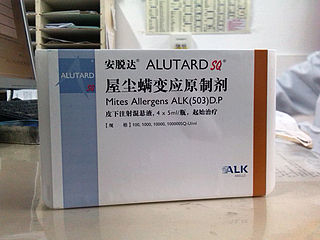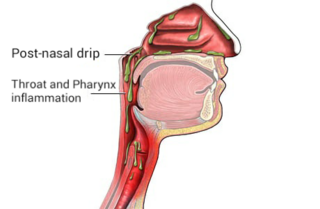
Allergies, also known as allergic diseases, are a number of conditions caused by hypersensitivity of the immune system to typically harmless substances in the environment. These diseases include hay fever, food allergies, atopic dermatitis, allergic asthma, and anaphylaxis. Symptoms may include red eyes, an itchy rash, sneezing, a runny nose, shortness of breath, or swelling. Food intolerances and food poisoning are separate conditions.

Allergic rhinitis, also known as hay fever, is a type of inflammation in the nose which occurs when the immune system overreacts to allergens in the air. Signs and symptoms include a runny or stuffy nose, sneezing, red, itchy, and watery eyes, and swelling around the eyes. The fluid from the nose is usually clear. Symptom onset is often within minutes following allergen exposure and can affect sleep, and the ability to work or study. Some people may develop symptoms only during specific times of the year, often as a result of pollen exposure. Many people with allergic rhinitis also have asthma, allergic conjunctivitis, or atopic dermatitis.

Rhinitis, also known as coryza, is irritation and inflammation of the mucous membrane inside the nose. Common symptoms are a stuffy nose, runny nose, sneezing, and post-nasal drip.

Nasal sprays are used to deliver medications locally in the nasal cavities or systemically. They are used locally for conditions such as nasal congestion and allergic rhinitis. In some situations, the nasal delivery route is preferred for systemic therapy because it provides an agreeable alternative to injection or pills. Substances can be assimilated extremely quickly and directly through the nose. Many pharmaceutical drugs exist as nasal sprays for systemic administration. Other applications include hormone replacement therapy, treatment of Alzheimer's disease and Parkinson's disease. Nasal sprays are seen as a more efficient way of transporting drugs with potential use in crossing the blood–brain barrier.

Allergen immunotherapy, also known as desensitization or hypo-sensitization, is a medical treatment for environmental allergies, such as insect bites, and asthma. Immunotherapy involves exposing people to larger and larger amounts of allergen in an attempt to change the immune system's response.

Post-nasal drip (PND), also known as upper airway cough syndrome (UACS), occurs when excessive mucus is produced by the nasal mucosa. The excess mucus accumulates in the back of the nose, and eventually in the throat once it drips down the back of the throat. It can be caused by rhinitis, sinusitis, gastroesophageal reflux disease (GERD), or by a disorder of swallowing. Other causes can be allergy, cold, flu, and side effects from medications.

Levocetirizine, sold under the brand name Xyzal among others, is an antihistamine used for the treatment of allergic rhinitis and long term hives of unclear cause. It is less sedating than older antihistamines. It is taken by mouth.

Azelastine, sold under the brand name Optivar among others, is a medication primarily used as a nasal spray to treat allergic rhinitis and as eye drops for allergic conjunctivitis. Other uses may include asthma and skin rashes for which it is taken by mouth. Onset of effects is within minutes when used in the eyes and within an hour when used in the nose. Effects last for up to 12 hours.

Azatadine (Optimine) is a first-generation antihistamine and anticholinergic that was launched by Schering-Plough in 1973.
Chronic atrophic rhinitis, or simply atrophic rhinitis, is a chronic inflammation of nose characterised by atrophy of nasal mucosa, including the glands, turbinate bones and the nerve elements supplying the nose. Chronic atrophic rhinitis may be primary and secondary. Special forms of chronic atrophic rhinitis are rhinitis sicca anterior and ozaena. It can also be described as empty nose syndrome.

Ebastine is a H1 antihistamine with low potential for causing drowsiness.

Rupatadine is a second generation antihistamine and PAF antagonist used to treat allergies. It was discovered and developed by J. Uriach y Cia and is marketed as Rupafin and under several other trade names.

Astragalus propinquus (syn. Astragalus membranaceus, commonly known as Mongolian milkvetch in English; 'Хунчир' in Mongolian; huáng qí, běi qí or huáng huā huáng qí, in Mongolia, is a flowering plant in the family Fabaceae. It is one of the 50 fundamental herbs used in traditional Mongolian medicine. It is a perennial plant and it is not listed as being threatened.

Setastine (Loderix) is an antihistamine used to treat allergies and rhinitis.

Fluticasone furoate is a corticosteroid for the treatment of non-allergic and allergic rhinitis administered by a nasal spray. It is also available as an inhaled corticosteroid to help prevent and control symptoms of asthma. It is derived from cortisol. Unlike fluticasone propionate, which is only approved for children four years and older, fluticasone furoate is approved in children as young as two years of age when used for allergies.

Bilastine, is a second-generation antihistamine medication which is used in the treatment of allergic rhinoconjunctivitis and urticaria (hives).
Nonallergic rhinitis is inflammation of the inner part of the nose that is not caused by an allergy. Nonallergic rhinitis involves symptoms including chronic sneezing or having a congested, drippy nose without an identified allergic reaction. Other common terms for nonallergic rhinitis are vasomotor rhinitis and perennial rhinitis. The prevalence of nonallergic rhinitis in otolaryngology is 40%. Allergic rhinitis is more common than nonallergic rhinitis; however, both conditions have similar presentation, manifestation and treatment. Nasal itching and paroxysmal sneezing are usually associated with nonallergic rhinitis in comparison to allergic rhinitis.

Rofleponide is a synthetic glucocorticoid corticosteroid which was never marketed.

Cidoxepin (former developmental code name P-4599), also known as cis-doxepin or (Z)-doxepin, is a tricyclic antidepressant which was developed in the 1960s but was never marketed. It is the cis or (Z) stereoisomer of doxepin, a mixture of (E) and (Z) isomers that is used commercially in a ratio of approximately 85:15 with cidoxepin as a relatively minor constituent. However, the drug has similar activity to that of doxepin, acting as a serotonin–norepinephrine reuptake inhibitor, H1 receptor antagonist, and anticholinergic, and notably is thought to have more antidepressant activity than trans-doxepin. The central anticholinergic activity of cidoxepin has been reported to be 3-fold greater than that of the trans isomer in mice.
Desloratadine/pseudoephedrine, sold under the brand name Clarinex-D among others, is a medication for the treatment of seasonal allergic rhinitis in adults and adolescents 12 years of age and older.
















